

A lifebuoy is a life-saving buoy designed to be thrown to a person in water to provide buoyancy and prevent drowning. [1] Some modern lifebuoys are fitted with one or more seawater-activated lights to aid rescue at night.


A lifebuoy is a life-saving buoy designed to be thrown to a person in water to provide buoyancy and prevent drowning. [1] Some modern lifebuoys are fitted with one or more seawater-activated lights to aid rescue at night.
Other names for "lifebuoy" include:
The lifebuoy is usually a ring- or horseshoe-shaped personal flotation device with a connecting line allowing the casualty to be pulled to the rescuer in a boat. They are carried by ships and boats and located beside bodies of water and swimming pools. To prevent vandalism, they are protected by fines (up to £5,000 in the United Kingdom) or imprisonment.
In the United States, Coast Guard approved lifebuoys are considered Type IV personal flotation devices. At least one Type IV PFD is required on all vessels 26 feet or more in length. [4]
In the UK the Royal Life Saving Society considers lifebuoys unsuitable for use in swimming pools because throwing one into a busy pool could injure the casualty or other pool users. In these locations, lifebuoys have been superseded by devices such as the torpedo buoy, [5] a low-drag device developed to be towed by lifeguards to those in danger.
Leonardo da Vinci sketched a concept for a safety wheel, as well as for buoyant shoes and balancing sticks for walking on water. [6]
According to various sources the Knights of Malta were the first to use cork lifebuoys on their ships. [7]
In the book Architectura naval antigua y moderna (1752) by Juan José Navarro, 1st Marquess of Victoria, two plates show "circular lifebuoys" and another plate includes a drawing of "a lifebuoy made of cork", called "salvenos". This is the type used systematically by the Knights of Malta on their ships. The lifebuoy was attached to a rope on one side and to the poop of the ship on the other, so that it may be deployed in case anyone should fall into the sea. [8] Navarro was Captain General of the Navy and is credited with the systematic introduction of the lifebuoy on all ships of the Spanish navy.
In 1803, a device called the "Marine Spenser" from the name of its inventor, Knight Spenser of Bread Street, was described in the Philosophical Magazine. [9] It was made of "800 old tavern corks" affixed to a band, "covered in canvass, and painted in oil, so as to render it waterproof." [10] The invention gained Spenser the honorary silver medal from the Royal Humane Society.
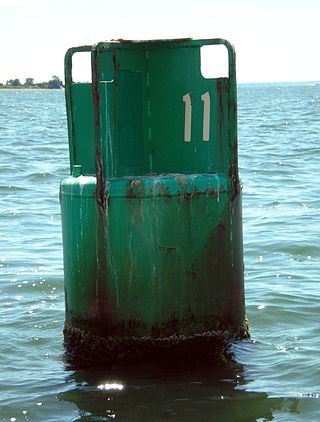
A buoy is a floating device that can have many purposes. It can be anchored (stationary) or allowed to drift with ocean currents.

Drowning is a type of suffocation induced by the submersion of the mouth and nose in a liquid. Submersion injury refers to both drowning and near-miss incident. Most instances of fatal drowning occur alone or in situations where others present are either unaware of the victim's situation or unable to offer assistance. After successful resuscitation, drowning victims may experience breathing problems, confusion, or unconsciousness. Occasionally, victims may not begin experiencing these symptoms until several hours after they are rescued. An incident of drowning can also cause further complications for victims due to low body temperature, aspiration, or acute respiratory distress syndrome.
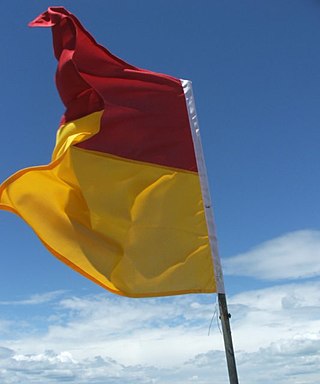
A lifeguard is a rescuer who supervises the safety and rescue of swimmers, surfers, and other water sports participants such as in a swimming pool, water park, beach, spa, river and lake. Lifeguards are trained in swimming and CPR/AED first aid, certified in water rescue using a variety of aids and equipment depending on requirements of their particular venue. In some areas, lifeguards are part of the emergency services system to incidents and in some communities, lifeguards may function as the primary EMS provider.

Boating is the leisurely activity of travelling by boat, or the recreational use of a boat whether powerboats, sailboats, or man-powered vessels, focused on the travel itself, as well as sports activities, such as fishing or waterskiing. It is a popular activity, and there are millions of boaters worldwide.
Life preserver or life-preserver may refer to:
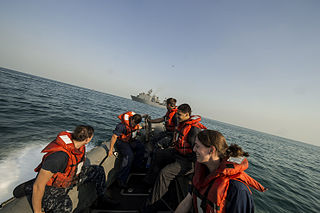
A personal flotation device is a flotation device in the form of a vest or suit that is worn by a user to prevent the wearer from drowning in a body of water. The device will keep the wearer afloat with their head and mouth above the surface – they do not have to swim or tread water in order to stay afloat and can even be unconscious.
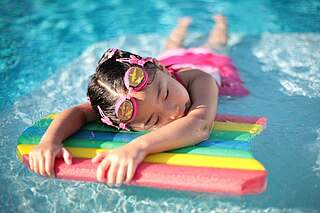
A swimming float, commonly known as pool float or floaty, is a device used for toddlers or other very young children who are beginning to learn how to swim, or during exercise for therapeutic or training purposes. These devices, which come in many shapes and types, are used to aid them with buoyancy, or for floating on for fun.

Inflatable armbands, usually referred to as simply armbands, water wings, swimmies, or floaties, are swim aids designed to help a wearer float in water and learn to swim.
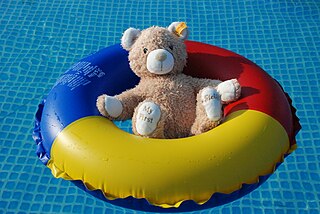
A swim ring is a toroid-shaped inflatable water toy.

Swimming lessons are the process of learning to swim. In most countries there is a definition of a number of swimming levels that are reached in the process of the curriculum. The respective certificates of swimming tests are required for further training in aquatic abilities. Many countries have defined a minimum swimming level that children should reach by the end of primary education, in most cases with the help of school swimming classes being part of the normal curriculum.
Life saver may refer to:

The Royal Life Saving Society Canada, commonly known as the Lifesaving Society or LSS, is a Canadian registered charity that works to prevent water-related injuries through various programs across Canada. The Lifesaving Society is an independent organization that is composed of ten provincial/territorial branches, tens of thousands of individual members, and over 4,000 affiliated swimming pools, waterfronts, schools and clubs. The Society helps prevent drowning and aquatic injury through its training programs, public education, drowning-prevention research, safety management and overseeing the sport of lifesaving. They are one of five nationally recognized first aid training organizations in Canada, alongside the Heart and Stroke Foundation, Red Cross, St. John Ambulance, and the Canadian Ski Patrol.
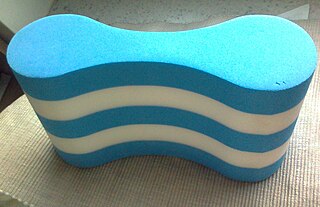
A pull buoy or leg float is a figure-eight shaped piece of closed-cell foam used in swim workouts. Swimmers place the buoy between their thighs or their ankles to provide support to the body without kicking their legs; this allows the swimmer to focus on training only their arms and developing both endurance and upper body strength.

Lifesaving is the act involving rescue, resuscitation and first aid. It often refers to water safety and aquatic rescue; however, it could include ice rescue, flood and river rescue, swimming pool rescue and other emergency medical services. Lifesaving also refers to sport where lifesavers compete based on skills, technique, speed and teamwork. Lifesaving activities specialized in oceanic environment is called surf lifesaving or coastal lifesaving.
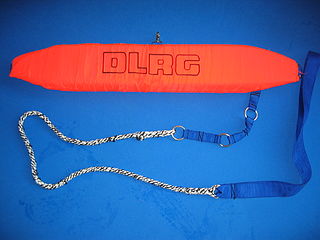
A rescue buoy or rescue tube or torpedo buoy is a piece of lifesaving equipment used in water rescue. This flotation device can help support the victim's and rescuer's weight to make a rescue easier and safer for the rescuer. It is an essential part of the equipment that must be carried by lifeguards. It further can act as a mark of identification, identifying an individual as a lifeguard.
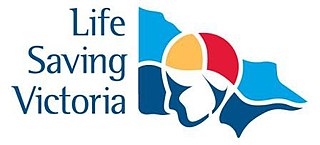
Life Saving Victoria is an Australian life saving organisation formed in 2002 from a merger of the Victorian Branch of the Royal Life Saving Society Australia and Surf Life Saving Victoria. Life Saving Victoria works to prevent drownings and other water related deaths and injuries in Victoria. Life Saving Victoria teaches local communities in Victoria about water safety, swimming and resuscitation. It also provides surf life saving services and patrols for beaches across the state. Life Saving Victoria is an emergency support agency to Victoria Police for water based emergencies.
E.M.I.L.Y. is a robotic device used by lifeguards for rescuing swimmers. Created by Hydronalix, a maritime robotic company, and funded by the United States Navy, EMILY operates on battery power and is operated by remote control after being dropped into the water from shore, a boat, pier, or helicopter. Using an impeller motor to travel through water, it is able to reach victims much faster than a human lifeguard can by swimming, and it is more compact and less expensive to maintain than crewed watercraft. It can also operate in weather and surf conditions that make other rescue attempts impractical. Once it reaches the victims its foam core allows it to function as a flotation device for four to six people holding onto side ropes or handles.
ISO 7010 is an International Organization for Standardization technical standard for graphical hazard symbols on hazard and safety signs, including those indicating emergency exits. It uses colours and principles set out in ISO 3864 for these symbols, and is intended to provide "safety information that relies as little as possible on the use of words to achieve understanding."
{{cite book}}: CS1 maint: numeric names: authors list (link)